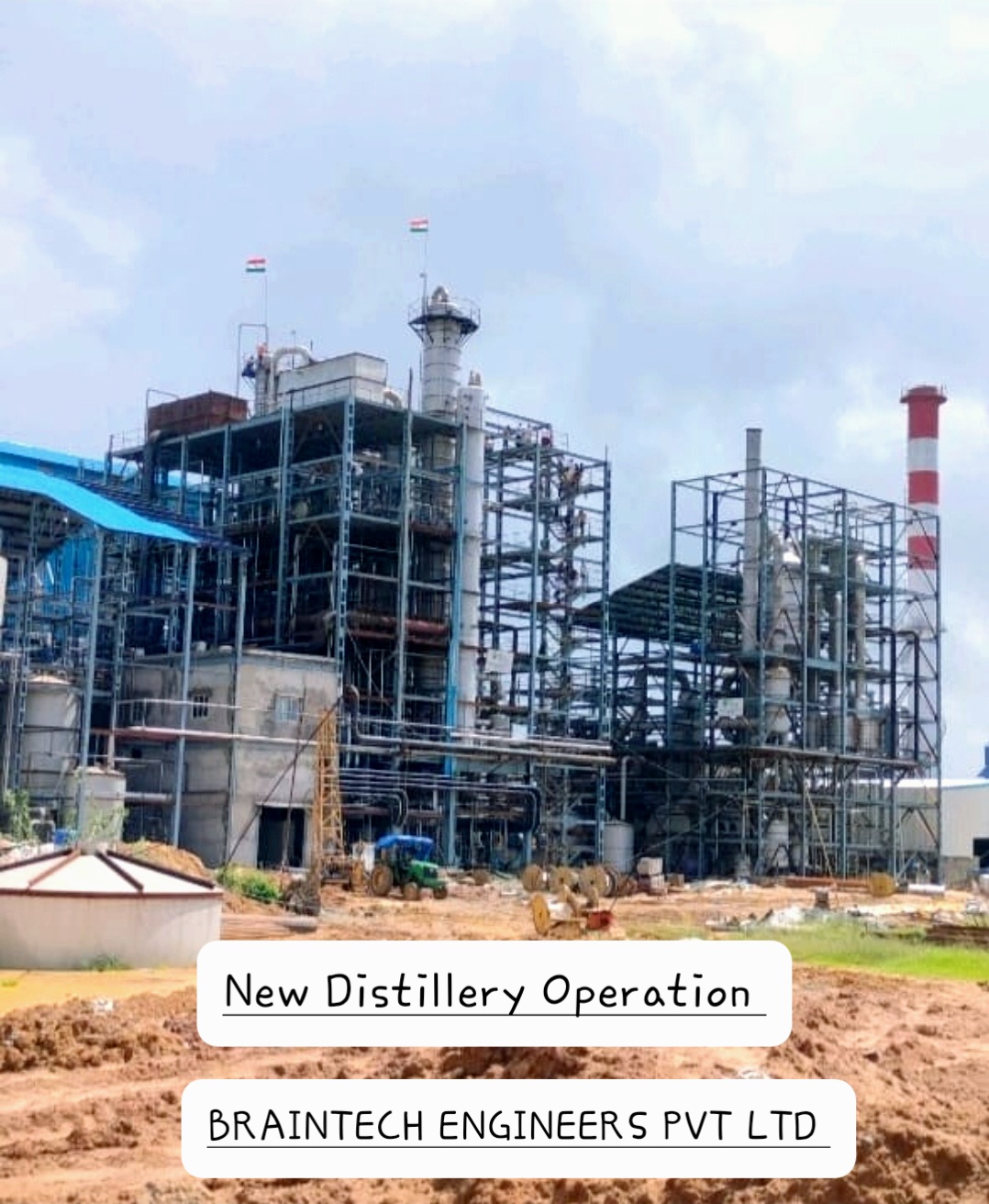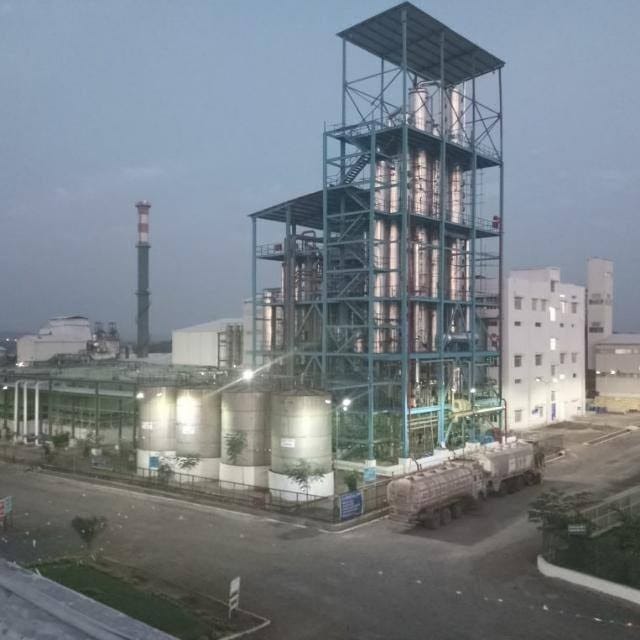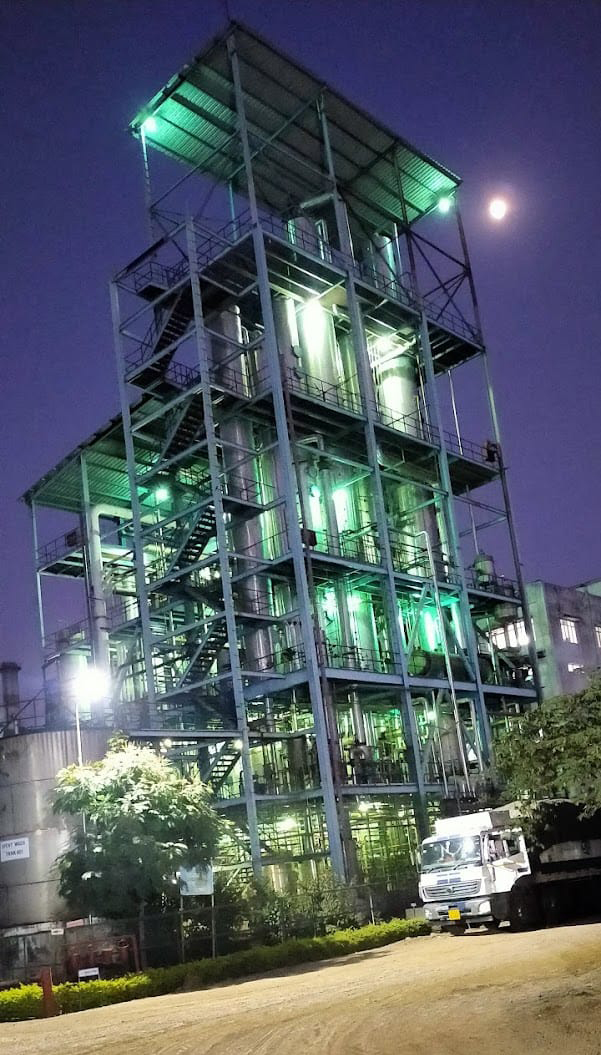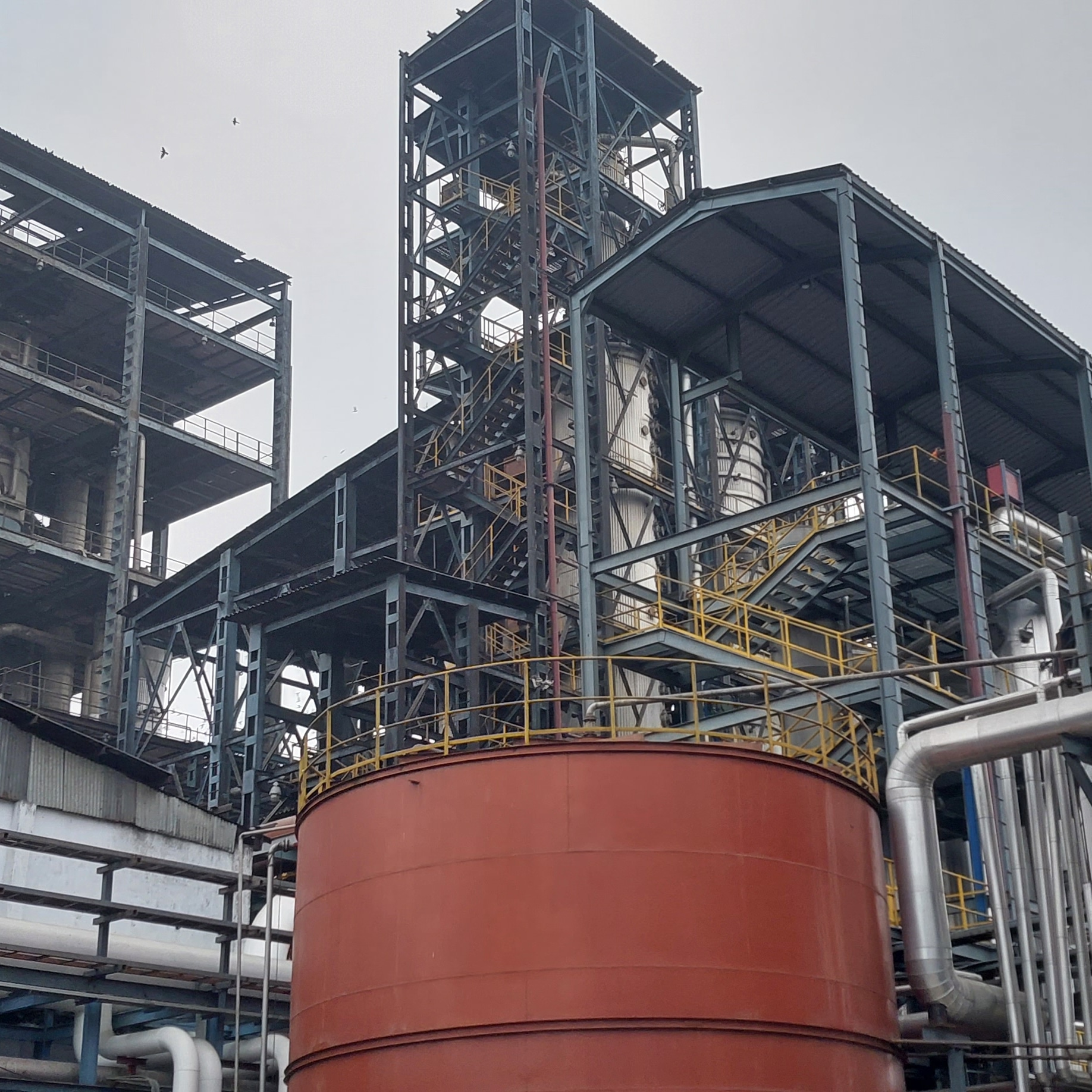Distillation Process
Grain Receiving, Storage and Milling:
Grain unloaded, is initially received by grain receiving hopper. From receiving hopper, grain is shifted to storage silo through screw conveyor and bucket elevator. The silo is well equipped with aeration facility so as to keep proper air circulation inside the silo. Some part of the dust that is carried along with the incoming grains is removed in this section. Pre-cleaned Grains are fed in controlled rate to the hammer mill. In this unit operation, Grain is broken down into small particles (flour) of required size distribution. Oversized particles are segregated with the help of vibratory screen. They are then recycled back to the hammer mill through the coarse bin. Flour from Vibratory screen is collected in the Hopper and then fed to the Slurry Mixing tank at a controlled rate.

Liquefaction:
The starch from the slurry is liquefied for sugar production. This is done in three steps liquefaction, continuous jet cooking and post-liquefaction. Heat stable enzymes are used for the process. The cooking process is done at high temperature to sterilize the slurry and to get high yields of sugar. This process is designed to maximize product yields using minimum process water and is based on classical concept of Simultaneous Saccharification and Fermentation. Hot Process water and recycled thin slop is added to Pre-masher to make slurry. The mixed slurry is taken to the Initial Liquefaction Tank where additional quantity of water is added as per requirement. Viscosity reduction Enzyme and stabilizing chemicals and a portion of liquefying enzyme are also added at this stage. This slurry is then “cooked” in the jet cooker. The slurry is continuously pumped to a steam jet cooker where high-pressure steam at 3.5 bar (g) / 147 °C rapidly raises the slurry temperature. The mixture of slurry and steam is then passed through the Retention vessel for desired retention time at a given flow rate. The cooked mash is discharged to a Flash Tank. The cooking process, accomplished in the above manner, converts the slurry into a hydrated, sterilized suspension (as starch molecule is solubilized) and is therefore susceptible to enzyme attack for liquefaction. The gelatinized mash from the Flash Tank is liquefied in the Final Liquefaction Tank where liquefying enzyme is added. The liquefied mash is cooled in Mash Coolers and transferred to Fermentation section for further action.

Fermentation:
During the fermentation, yeast strains of the species Saccharomyces Cerevisiae, a living microorganism belonging to class fungi converts sugar (Glucose, Fructose, Sucrose, Maltose or Maltotrioes) present in the Cane Syrup or sugar cane juice to alcohol. However, Saccharomyces Cerevisiae cannot use starch as such. To produce alcohol from starch containing raw materials such as grains or cassava etc. by fermentation, the starch has to first hydrolyze to glucose. Industrially, this conversion is accomplished by the cooking of starch slurry and use of enzymes to breakdown the polymers of glucose (Amylose and Amylopectin), Transformation of starch to glucose consists of Gelatinization (Cooking), Liquefaction and Saccharification.
Chemically this transformation to alcohol can be approximated by the equation.
Enzymes
n (C6H10O5) + n(H2O) → n(C6H12O6)
Starch (162) Water (18) Glucose (180)
Yeast
Yeast C6H12O6 → 2 C2H5OH + 2CO2
Glucose (180) Ethanol dioxide (92) + Carbon (88)
As per the above reaction, 162 gm of starch produces 180 gm of glucose. Therefore, 1 MT of starch gives 1111.11 gm of glucose. 180 gm. of glucose on reaction gives 92 gm. of alcohol. Therefore, 1 MT of sugar gives 511.1 kgs of alcohol. The specific gravity of alcohol is 0.7934, therefore, 511.1 kg of alcohol is equivalent to 511.1/0.7934 = 644.19 liters of Alcohol. During fermentation, other by-products like glycerin, succinic acids, etc also are formed from sugars. Therefore, actually, 94.5% of total fermentable sugars are available for alcohol conversion. Thus, one MT of sugar will give only 644 x 0.945 = 608.6 liters of alcohol, under ideal conditions theoretically. Similarly, one MT of pure starch should give 715.0 liters of alcohol under ideal conditions, theoretically (at 100 % efficiency and 100 % ethanol). Corn or sorghum contains about 62.0 % starch on a dry weight basis. Therefore, one MT of corn or sorghum can yield about 410 Liters of Rectified Spirit. For bringing out above biochemical reaction, we require proper and careful handling of yeast, control of optimum parameters like pH and temperature and substrate concentration and enzyme dose, which results into the effective conversion of starch to sugars and then to alcohol. The purpose of fermentation is to convert sugars into alcohol. Simultaneously Carbon dioxide is produced in Stoichiometric proportions and is scrubbed before being discharged. There are closed top Fermentation tanks with adequate external cooling system to maintain optimum fermentation temperatures. Agitators are also provided to ensure mixing and suspension of substrate in the tank. Anaerobic conditions are maintained to For bringing out above biochemical reaction, we require proper and careful handling of yeast, control of optimum parameters like pH and temperature and substrate concentration and enzyme dose, which results into the effective conversion of starch to sugars and then to alcohol. The purpose of fermentation is to convert sugars into alcohol. Simultaneously Carbon ensure high reaction rates and CO2. Typically, 4 Nos. of fermenters are provided with Beer well of same capacity. After transfer process is complete, empty fermenters is put to CIP cycle. Yeast seed material is prepared in water-cooled vessels by inoculating sterilized mash with active dry yeast. Optimum temperature is maintained by circulation of cooling water. The contents of the yeast vessel are then transferred to Pre-Fermenter. The pre-fermenters are filled with mash and loaded with contents of the yeast vessel. The purpose of the aerated pre-fermentation is to allow time for the yeast cells to multiply and reduce the chances of contamination in fermenters. When the Pre-Fermenter contents are transferred to the main fermenters, the concentration of Yeast cells are high enough to substantially reduce the lag time associated with yeast growth in fermentation. Saccharifying enzymes are added in the fermenters. These convert the starch into sugars. This is basically conversion of Dextrin into Dextrose. The purpose of fermentation is to convert the fermentable substrate into alcohol. To prepare the mash for fermentation, it has to be diluted with water. The pH of the mash is adjusted primarily by recycled slops (which also provides for nutrients) or by the addition of acid. Yeast is available in sufficient quantity to initiate fermentation rapidly and complete it within 45 hours. At the start of the cycle, the Fermenter is charged with mash and contents of the pre – fermenter. Significant heat release takes place during fermentation. This is removed by forced circulation cooling in external heat exchangers. The recirculating pumps also serve to empty the fermenters into beer well. After the fermenters are emptied, they are cleaned with water and caustic solutions and sterilized for the next batch. Six fermenters are provided for Grain operation. CO2 evolved during fermentation carries along with it some entrained alcohol. This CO2 is taken to a CO2 scrubber where it is washed with water to recover the entrained alcohol. The scrubbed CO2 can then be taken to CO2 recovery plant.
Multi-Pressure Distillation for Wash to Rectified Spirit:
Multi – pressure distillation scheme has three distillation columns. These columns operate under different pressure conditions. Energy from column operating under high pressure is re utilized by column operating under low pressure to conserve energy. The columns in order of flow are:
- Mash/Stripping Column
- Rectification Column
- Aldehyde cum Recover Column
Fermented wash is preheated in the Fermented Wash Pre heater and fed at the top of the Mash/Stripping column. This column is provided with Re-boilers. Top vapors of Mash/Stripping column containing all the alcohol in the wash are sent to Rectification column. Rest of the fermented wash flows down the Mash/Stripping column and is taken out as spent wash from column bottom. In Rectification column, higher volatile ethanol component is separated from ethanol plus water binary mixture. Rectified Spirit draw is taken from the top of Rectification column, which is sent to Molecular Sieve Dehydration Fuel Ethanol Plant. In the Aldehyde cum Recovery column, fusel oils are concentrated and then sent to decanter where these streams are diluted with water and fusel oil rich layer is separated. Technical alcohol cut is taken out and recycled into the system

Molecular Sieve Dehydration (Fuel Ethanol Plant):
Molecular sieve technology works on the principle of pressure swing adsorption. Here water is removed by adsorbing on surface of `molecular sieves’ and then cyclically removing it under different conditions (steaming). Molecular sieves are nothing but synthetic zeolites typically 3Ao zeolites. Zeolites are synthetic crystalline Alumino silicates. This material has strong affinity for water. They adsorb water in cold condition and desorb water when heated. This principle is used to dehydrate ethanol. The crystalline structure of zeolites is complex and gives this material the ability to adsorb or reject material based on molecular sizes. Water molecule can enter the sieve and be adsorbed, but larger alcohol molecule will not be retained and will go through the bed. There can be two to three beds in parallel. Once a particular bed is saturated with water, it is heated with steam so that adsorbed water is desorbed from the bed. Till that time, other bed is used for dehydration. Vapour of Rectified Spirit at around 95% v/v are passes through a bed containing alumino,silicate adsorbent bed material. This removes extra amount of moisture from spirit and output is Fuel Ethanol or Absolute Anhydrous alcohol of more than 99.8% v/v which is suitable for blending in petrol and also pharmaceutical applications.

Decantation Section:
Decantation section comprises of a Centrifuge Decanter for separation of suspended solids from Spent Wash coming out of Grain Distillation Plant. Wet cake is removed from bottom of 15 Decanter. Spent wash/Thick Slops from Mash Column is pumped to Thick Slops Tank. Thick Slops is then fed to Decanter Centrifuge through Decanter Feed Pump. In Decanter suspended solids from Thick Slop are separated and removed as Wet Cake while Thin Slops is collected in Thin Slops Tank. Thin slops from this tank are then fed to Evaporator for further concentration.
Thin Slop Evaporation:
Thin slop evaporation plant is designed to concentrate thin slop coming out of decantation unit from 5% to 30% w/w solid concentration. This evaporation plant is multi-effect and combination of falling film & forced circulation type. Evaporation is integrated to distillation and DDGS dryer for energy conservation. The product at the desired concentration of 40% w/w total solid is obtained at the outlet of the final effect. Each effect is provided with recirculation cum transfer pumps. The condensate from surface condensers is collected in a common condensate pot. The condensate is transferred for further treatment / drain by using centrifugal pump. The system operates under vacuum. Water-ring vacuum pumps are used to maintain a desired vacuum. Cooling water from cooling tower is used in the surface condensers for condensing the vapors.
DDGS Dryer:
Wet cake with 30% w/w solids concentration from decantation section and Concentrated Syrup with 30% w/w solids concentration produced in evaporation section are mixed together & fed into the dryer housing at controlled rate through a suitable feeding system. The Rotary Tube Bundle is enclosed in an insulated dryer housing and on its outer flights are fixed. Dry, saturated steam is to be supplied to the tube bundle through rotary joint at one end & the condensate is discharged through rotary joint mounted of another end. The heat transfer is primarily by conduction. The water vapours are exhausted through an Exhaust Blower & passed through a cyclone separator for separating fines. Dry product partially recycled back to Feed conditioner for feed conditioning through Product Screw & Recycle Conveyor. Colourless effluent such as spent lees, process condensate, washings, blow downs are treated in a Condensate Polishing Unit and recycled back to process.
